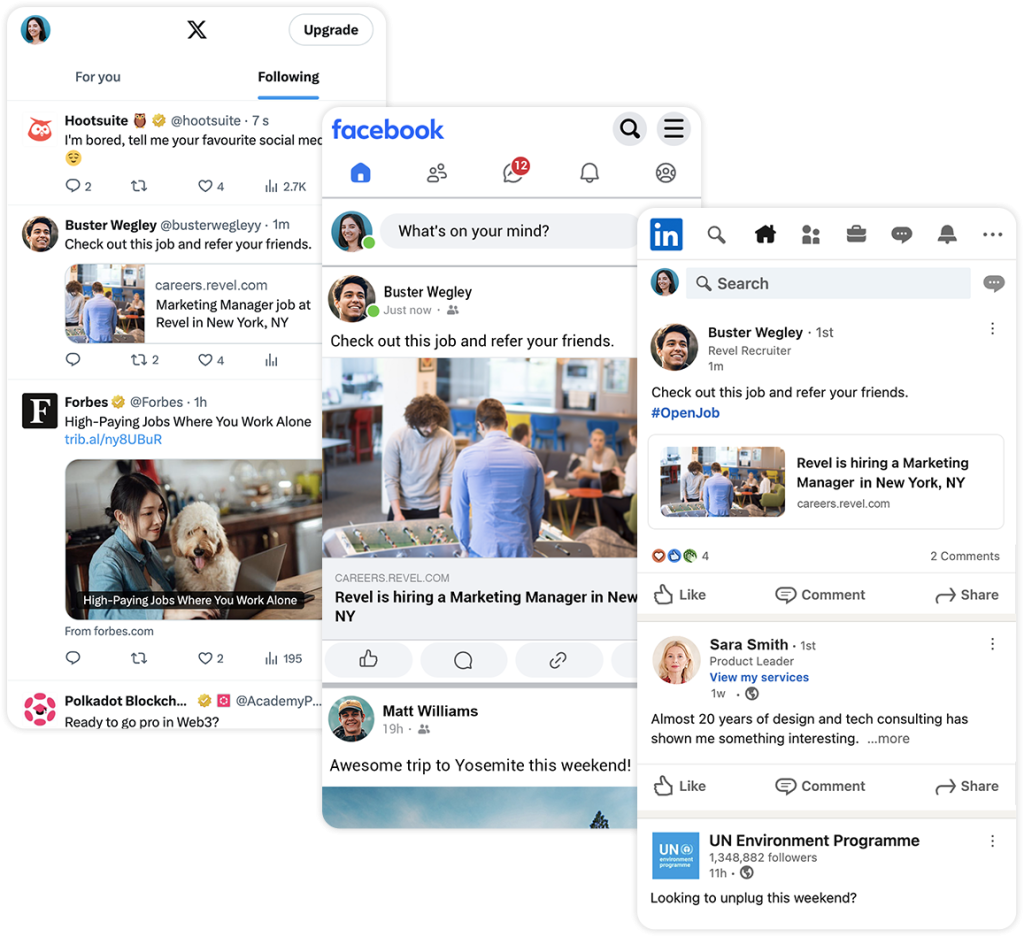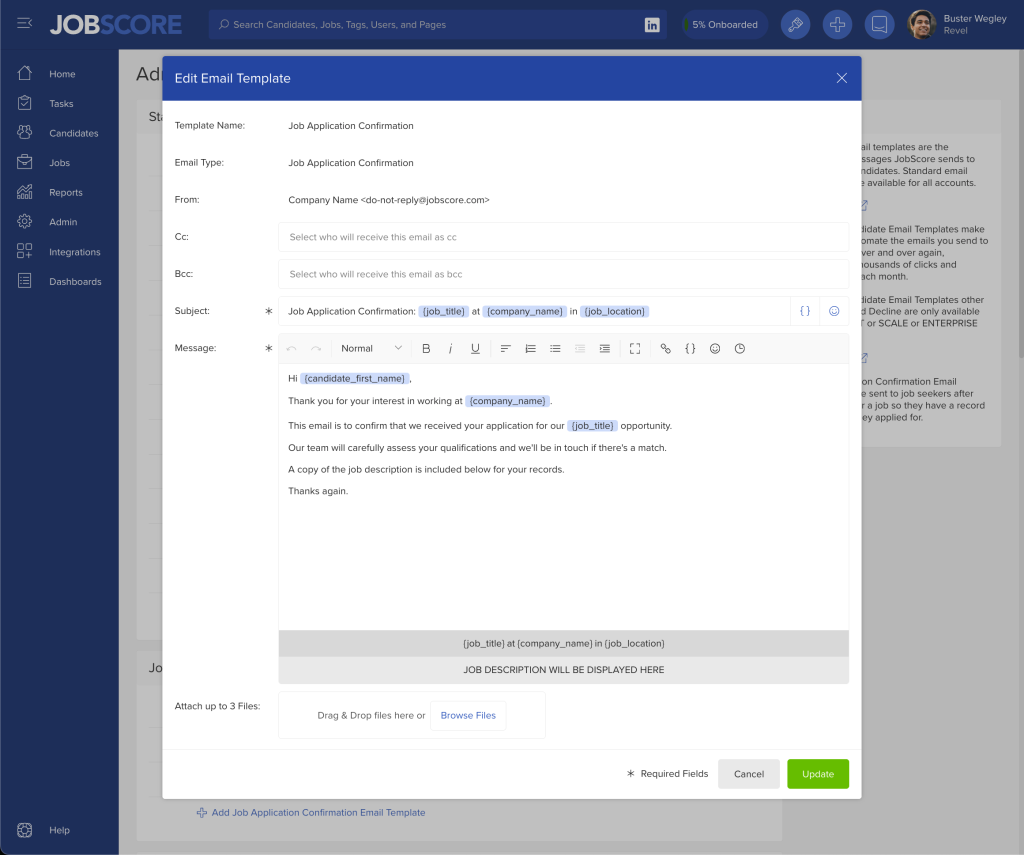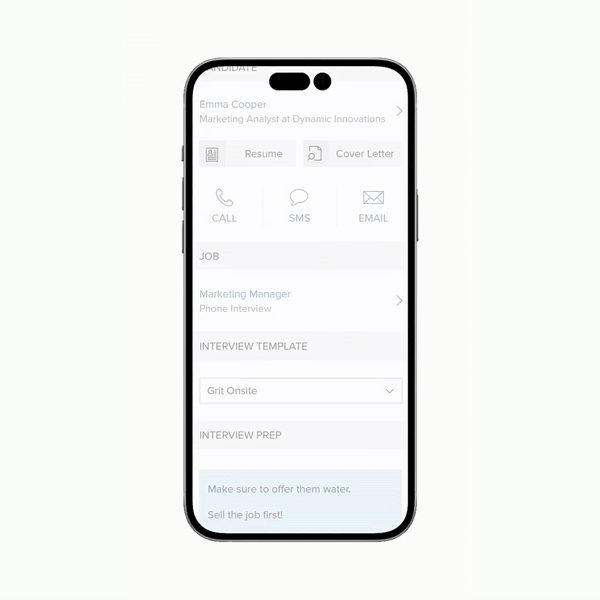
Subscribe for updates
Get talent acquisition best practices, trends, and news delivered directly to your inbox.
By entering your email, you agree to receive marketing emails from JobScore
Your employer brand shapes how candidates perceive your organization — and whether they want to work for you. Every interaction with your company, from discovering your job posting to receiving a rejection email, contributes to their overall impression. These moments matter because more than a third of candidates take your employer brand into consideration when evaluating a job offer. That means that your top choice candidate’s decision to join your team may rest on the experiences of every candidate and employee who’s ever walked through your doors.
Having the right tools in place — including an applicant tracking system — can help strengthen your employer brand so you can win over your top choice candidates.
The benefits of investing in the right employer branding tools
Building a strong employer brand requires the right foundation. An applicant tracking system is an important tool to have at your disposal because it touches so many parts of your candidate journey.
Using the right applicant tracking system to enhance your employer branding efforts can have many benefits.
Higher quality applicants
Strong employer branding attracts better candidates. You naturally draw candidates whose values align with your organization when your brand resonates with job seekers. This means less time sorting through applications from people who aren’t a good fit and more time engaging with candidates who could become excellent team members.
Quality applicants also tend to be more engaged throughout your hiring process. They’ve done their research, they understand your company culture, and they’re genuinely interested in contributing to your team’s success.
Improved candidate experience leads to positive reviews
The way you treat candidates during recruitment directly impacts your online reputation. According to Universum’s 2024 research, 68% of talent professionals from the world’s most attractive employers prioritize employer branding, with a particular focus on inspiring purpose as a critical component of their employer value proposition.
Candidates remember their experiences — good and bad. When you provide a thoughtful, respectful candidate experience, those candidates become advocates for your brand. They share positive reviews on sites like Glassdoor and Indeed, recommend your company to friends, and may even apply again for future opportunities.
The inverse is equally true. Poor candidate experiences lead to negative reviews that can damage your reputation and make it harder to attract talent. Every touchpoint in your recruiting process is an opportunity to strengthen or weaken your employer brand.
Reduced hiring costs through organic attraction
Candidates come to you when your employer brand is strong. This organic attraction reduces your dependence on expensive job boards and recruiting agencies.
Strong employer branding also reduces your cost per hire. You spend less time and money convincing candidates to apply when they already want to work for you. Your job postings get more views, your career site gets more traffic, and your team builds a robust talent pipeline much faster.
Better retention and team member engagement
Employer branding doesn’t stop once someone accepts your offer. The promises you make during recruitment set expectations for the employee experience. Delivering on those promises builds trust and loyalty that translates into better retention rates.
New team members who felt valued during the hiring process are more likely to feel engaged from day one. They arrive excited about their role and ready to contribute. This positive momentum often carries through their entire tenure with your organization.
Competitive advantage in talent acquisition
A strong employer brand gives you an edge when competing for top talent. You become the first choice for skilled professionals in your industry when your organization is known for treating candidates and team members well.
This advantage becomes especially valuable when recruiting for hard to fill positions. Passive candidates are more willing to consider opportunities at companies with positive reputations. Your brand does the heavy lifting, making it easier for recruiters to start conversations with top talent.
The role of ATS in employer branding
Your ATS serves as the technology backbone for your entire recruiting operation. The right system enables you to create consistent, positive experiences at every stage of the candidate journey.
Branded careers site and job postings
First impressions matter in recruitment. Your careers site is often the first place candidates interact with your brand, and it needs to reflect your company’s unique culture and values. A modern ATS helps you create a careers site that looks professional, loads quickly on any device, and showcases what makes your organization special.
Customization is essential. Your careers site should feature your logo, colors, and imagery that represents your team. You want candidates to immediately recognize your brand and feel excited about potential opportunities. The best ATS platforms make this customization easy, requiring no coding knowledge to create a site that looks and feels like an extension of your main website.
Job postings also play a crucial role in employer branding. Your ATS should enable you to create compelling job descriptions that go beyond basic requirements and responsibilities. Include information about your company culture, team dynamics, growth opportunities, and unique benefits. This context helps candidates determine whether they’re a good fit while simultaneously marketing your organization.

Employee advocacy programs
Your current team members are your best brand ambassadors. They have authentic stories to share about working at your company, and candidates trust employee advocacy more than corporate messaging. An ATS that supports employee referral programs makes it easy for your team to share open positions with their networks.
When team members can quickly share job openings on social media or directly with contacts, you expand your reach to passive candidates who might not be actively job searching. These referrals often result in higher quality hires because your team members naturally recommend people who would thrive in your culture.
Employee advocacy also strengthens your employer brand externally. When your team actively promotes your organization and its opportunities, it signals to candidates that your people genuinely enjoy working for you. This organic endorsement is more powerful than any recruiting ad.

Mobile-friendly, frictionless applications
Today’s candidates increasingly use mobile devices to search for jobs and submit applications. You’re losing qualified candidates before they even apply if your application process isn’t optimized for mobile,
A modern job application should be simple and intuitive. Long, complicated forms frustrate candidates and lead to drop-off. Your ATS should enable candidates to apply with minimal friction — whether that means importing information from LinkedIn, uploading a resume that auto-populates fields, or answering just a few key questions.
The application experience sets the tone for everything that follows. When candidates can apply quickly and easily from any device, they start their journey with your company on a positive note. This good impression carries through the rest of the recruiting process and influences their overall perception of your employer brand.
Personalized, automated candidate communications
Communication is one of the most critical aspects of candidate experience, yet it’s where many organizations struggle. Poor communication is consistently cited as a top frustration among job seekers. Your ATS should help you stay in touch with candidates throughout their journey, from application confirmation to final decisions.
Automated recruiting email templates ensure that no candidate falls through the cracks. When someone applies, they should immediately receive confirmation. When they advance to interviews, they should get clear details about what to expect. When you make a decision, they should hear from you promptly — whether the news is positive or negative.
Personalization takes automated communication to the next level. Generic emails feel impersonal and transactional. Your ATS should enable you to customize messages with candidate names, position details, and other relevant information. This personalized approach shows candidates that you see them as individuals, not just resume numbers in a database.

Structured hiring process
Consistency in your hiring process improves both candidate experience and hiring outcomes. Structured interviews and standardized evaluation criteria help you create a fair and professional hiring process. This consistency also helps you make better hiring decisions by reducing bias and improving comparability between candidates.
Your ATS should support structured hiring by providing features like interview scorecards. These tools help interviewers evaluate candidates objectively and provide consistent feedback. When everyone on your hiring team uses the same framework, you create a more equitable process that strengthens your employer brand.

Structured processes also make your hiring more efficient. When team members know exactly what they need to evaluate and how to document their assessments, interviews move more smoothly. Candidates appreciate this professionalism, and your team wastes less time in coordination meetings trying to compare notes about different candidates.
Transparency and feedback loops
Candidates want to understand where they stand in your process. Transparency about timelines, next steps, and decision criteria builds trust and improves the candidate experience. Your ATS should make it easy to keep candidates informed throughout their journey.
Feedback is equally important. While you can’t provide detailed feedback to every applicant, offering constructive insights to candidates who’ve invested significant time in your process demonstrates respect and professionalism. This approach leaves candidates with a positive impression even when you don’t extend an offer.
Candidate experience surveys provide valuable feedback loops for improving your process. Your ATS should enable you to automatically request feedback at key stages — after applications, following interviews, and post-hire. This data helps you identify friction points and continuously improve your employer brand.
Measurement and analytics
You can’t improve what you don’t measure. Your ATS should provide robust analytics that help you understand how candidates experience your brand. Track metrics like time to hire, candidate satisfaction scores, and source quality to identify opportunities for improvement.
Employer branding metrics reveal patterns that might not be obvious otherwise. For example, if you notice high drop-off rates during the hiring process, you might need to combine or remove a stage or two. If candidates consistently rate communication poorly in surveys, spend some time building email templates and putting systems in place to encourage better communication.
Analytics also help you demonstrate the ROI of employer branding investments. It’s easier to secure ongoing support for your initiatives when you can show how improvements to candidate experience lead to higher offer acceptance rates, better quality hires, and reduced time to hire.
How to choose the right ATS for employer branding
Not all applicant tracking systems are created equal when it comes to supporting your employer brand. Focus on these key capabilities when evaluating options.
Customizable careers site and brand integration
Your ATS should offer extensive customization options for your careers site. Look for platforms that let you incorporate your brand colors, fonts, logos, and imagery without requiring technical expertise. The best systems provide drag-and-drop builders that make it easy to create a professional, branded experience.
Consider how the careers site integrates with your main website. Candidates should experience a seamless transition when moving from your company site to your careers page. Jarring design differences or obvious third-party branding can undermine the professional impression you’re trying to create.
Communication and candidate engagement tools
Evaluate the communication capabilities carefully. Your ATS should support automated email workflows that can be customized for different roles, stages, and candidate segments.
The ability to personalize communications at scale is essential. Your ATS should make it easy to include candidate names, position titles, and other relevant details in automated messages. Some systems also support conditional logic, allowing you to send different messages based on candidate characteristics or actions.
Integration with other tools
Your ATS doesn’t exist in isolation. It should integrate smoothly with your other technology tools, including your HRIS, calendar systems, video interviewing platforms, and background check providers. These integrations reduce manual work for your team and create a better experience for candidates.
Social media integration is particularly important for employer branding. Your ATS should make it easy to share job postings across LinkedIn, Facebook, and other platforms. Employee referral features should enable team members to share opportunities through their preferred channels with minimal friction.
Reporting and analytics capabilities
Strong analytics capabilities help you understand and improve your employer brand over time. Look for systems that provide dashboards with key metrics like application sources, conversion rates at each stage, and time to hire.
The ability to segment data is valuable. You might want to compare metrics across different positions, departments, or locations. Custom reports help you identify trends and make data-driven decisions about your recruiting strategy and employer brand investments.
Mobile optimization and accessibility
Your ATS must deliver excellent experiences on mobile devices. Candidates increasingly search for jobs and submit applications from smartphones and tablets. You’ll lose qualified candidates to competitors with better mobile experiences if your system isn’t mobile-optimized.
Final thoughts on using your applicant tracking system for employer branding
Your applicant tracking system is more than an operational tool — it’s a strategic asset for building and maintaining your employer brand. The right ATS helps you create consistent, positive experiences that shape how candidates perceive your organization.
Strong employer brands don’t happen by accident. They result from deliberate choices about how you interact with candidates at every stage of the recruiting process. When your ATS enables you to communicate effectively, provide transparent information, and treat every candidate with respect, you build a reputation that attracts top talent.
The investment in employer branding through your ATS pays dividends beyond individual hires. You’ll see higher quality applicant pools, better offer acceptance rates, improved retention, and reduced recruiting costs. These benefits compound over time as your reputation grows stronger.
As you evaluate applicant tracking systems, prioritize features that support positive candidate experiences. Look for platforms that make it easy to showcase your culture, communicate consistently, and gather feedback for continuous improvement. The right technology foundation enables you to build an employer brand that becomes a sustainable competitive advantage.



